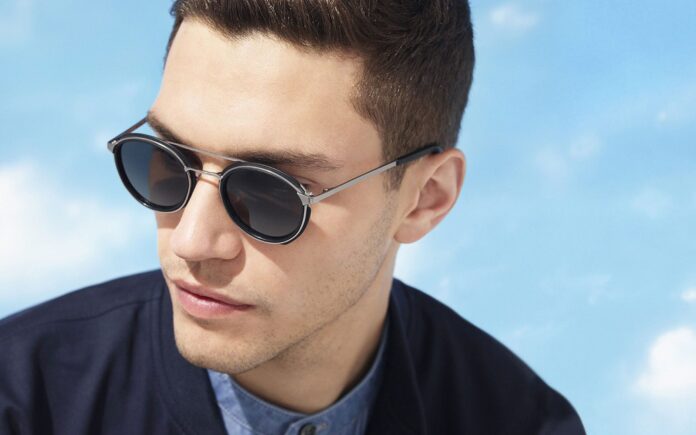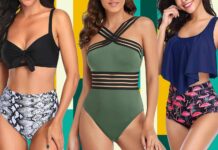Choosing the right pair of sunglasses is really important when it comes to protecting your eyes; it is also crucial for making you look stylish.
With so many options on the market, it might seem an impossible task to try to choose a shade that complements your facial features.
Understand the Different Face Shapes

When shopping for sunglasses, the most significant factor is your face shape. To that end, there are five basic face shapes that individuals typically fall into:
Oval Face Shape
The oval face is thought of as the ideal shape. It is rounded with balanced proportions and has no prominent angular lines.
The width of an oval face is approximately one-and-a-half times the length. Oval is the most versatile face shape in terms of what sunglass styles will look good on it.
Round Face Shape
As the name suggests, the round face shape features a circular form and has full cheeks. The length and width of a round face are roughly equal. Those with rounder faces will want to create the illusion of more angles with their eyewear.
Square Face Shape
The square face has a strong jawline and angular features. The length and width of the square face are almost identical. For this shape, sunglasses that soften harsh lines are probably the best.
Heart Face Shape
This shape features a wide forehead and cheekbones that taper down to a pointed chin. Heart-shaped faces can wear nearly any sunglass style since the top and bottom halves contrast nicely.
Diamond Face Shape
The distinguishing quality of a diamond face is prominent cheekbones with a narrow eye line and petite forehead and chin. Like the oval and heart shapes, diamond faces generally look nice in most sunglasses.
Choose Frames Based on Your Face Shape

With your unique face shape identified, you can start looking for those sunglasses that are made to enhance your features. The following is what tends to work best for each:
Oval Faces
Lucky oval faces can choose nearly any sunglass shape and look fabulous. Experiment widely with oversized cat-eye frames, circular lenses, or classic aviators.
Depending on your exact proportions, some shapes, like rectangular, might overwhelm those with longer oval faces.
Round Faces
To add definition, go for square, rectangular, or other angular frames. Cat-eye shapes are ideal for making round faces seem less circular. Overly rounded styles accentuate fullness, so stick with a more structured look.
The experts over at Olympic Eyewear recommend designer sunglasses like the iconic Ray-Ban Wayfarer, which add striking lines that slenderize round shapes.
Square Faces
Prioritize frames that soften your sharp jawline and provide curve contrast. Styles like oval, round, and cat-eye flatter square faces best.
Overly boxy models extend your natural lines instead of balancing them out. Avoid very small or narrow looks that make square jaws appear wider.
Heart Faces
Heart face shapes have flexibility for wearing all different sunglass silhouettes. But classic aviators and wayfarers usually complement their features most attractively.
Stay away from narrow frames that highlight a tapered chin. Overly dainty styles also emphasize the widest part of heart faces.
Diamond Faces
Like heart shapes, diamond faces tend to suit both angular and rounded frames depending on personal style. Wayfarers and aviators are classics.
Oversized circles also widen narrow eye lines stylishly. Just avoid large, heavy-looking frames that overwhelm a petite forehead and chin.
UV Protection
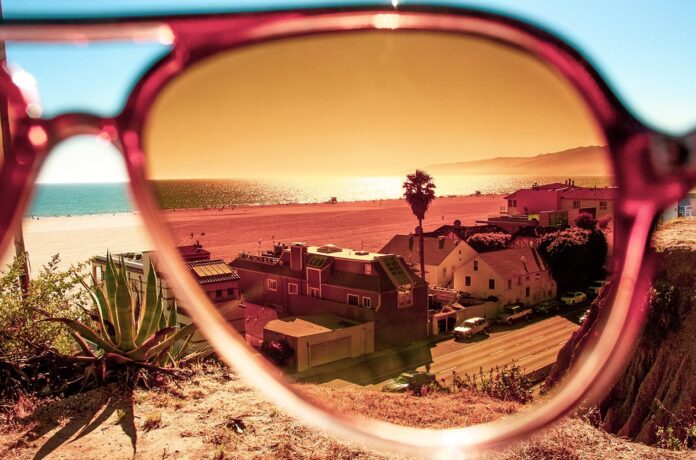
Selecting sunglasses with adequate UV protection is crucial for maintaining eye health.
Prolonged exposure to harmful UV rays can lead to conditions such as cataracts, macular degeneration, and photokeratitis, essentially a sunburn of the eyes. UV protection in sunglasses is not related to the color or darkness of the lenses but to a clear coating applied to them.
Therefore, ensuring your sunglasses block 99% to 100% of UVA and UVB rays is essential, regardless of the climate or your outdoor activities’ nature.
This protection is indispensable for preserving your vision’s long-term health and preventing sun-related eye damage.
Polarized Lenses
Polarized lenses offer significant benefits by reducing glare from reflective surfaces, making them ideal for driving, fishing, skiing, and other outdoor activities. This reduction in glare enhances visual clarity and comfort, reducing eye strain.
However, it’s essential to understand that polarization itself does not equate to UV protection; both features can coexist in a pair of sunglasses for optimum eye safety and visual comfort.
Whether navigating water bodies or hitting the slopes, polarized lenses can transform your experience by filtering out the harsh glare that bounces off flat surfaces.
Lens Tint
The tint of sunglass lenses plays a pivotal role in how well they perform under various lighting conditions. For instance, gray lenses offer a neutral view, making them suitable for general use and maintaining true color perception.
In contrast, brown or amber lenses enhance contrast and depth perception, making them excellent for bright sunlight conditions. They can help improve the visibility of objects in sports like golf or baseball.
Other tints, such as yellow or orange, are beneficial in low light conditions, enhancing contrast but can distort colors. Choosing the right lens tint can significantly impact your visual comfort and performance in specific environments.
Frame Material
The material of sunglass frames significantly influences their durability, comfort, and style. Lightweight and flexible materials like nylon are ideal for active use, offering resilience against impacts and bends.
On the other hand, acetate frames provide a wide range of textures and colors, offering a stylish look alongside durability.
Metal frames are classic and adjustable, with a sleek appeal but may require more careful handling.
The choice of frame material should align with your lifestyle, ensuring that your sunglasses can withstand your activities without compromising on style or comfort.
Lens Material
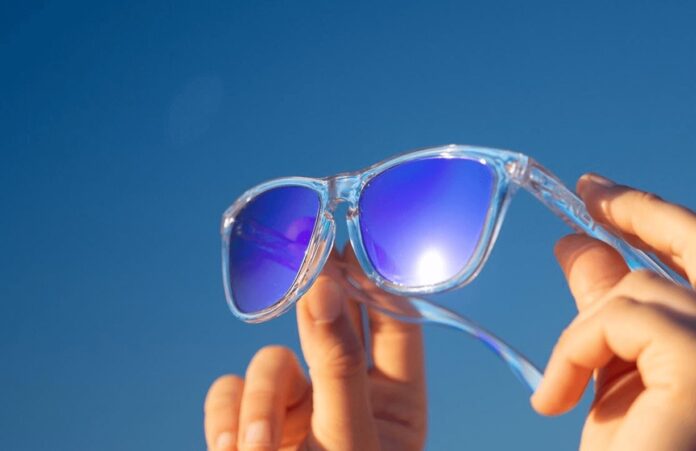
Lens material affects the weight, clarity, and durability of sunglasses. Polycarbonate lenses are known for their impact resistance, making them a popular choice for sports and children’s sunglasses.
Despite being lightweight and strong, they can scratch more easily than glass lenses. Glass lenses offer superior clarity and are more resistant to scratching. However, they are heavier and can shatter upon impact.
The decision between polycarbonate and glass lenses should consider your priorities, whether it’s the ultimate clarity for driving or durability for active pursuits.
Fit and Comfort
A good fit is crucial for the effectiveness and comfort of sunglasses. Ill-fitting sunglasses can lead to discomfort, marks on the nose, or even headaches from prolonged wear.
Features such as adjustable nose pads and flexible temple tips can enhance the fit, ensuring the sunglasses rest comfortably on your face without slipping.
The width of the frames should match the width of your face, and the lenses should cover your eyes fully, protecting them from all angles.
Comfort should never be overlooked, as it determines how likely you are to wear your sunglasses consistently, thereby protecting your eyes.
Style Versatility
Sunglasses that offer style versatility can seamlessly transition from casual to formal settings, making them a valuable accessory for everyday use.
A classic shape like aviators or wayfarers can complement various outfits and occasions, providing both functionality and fashion.
Investing in a versatile pair means you can enjoy the benefits of protection, comfort, and style without needing multiple pairs for different settings.
This not only offers practicality but also ensures you can maintain consistent eye protection regardless of your attire.
Conclusion
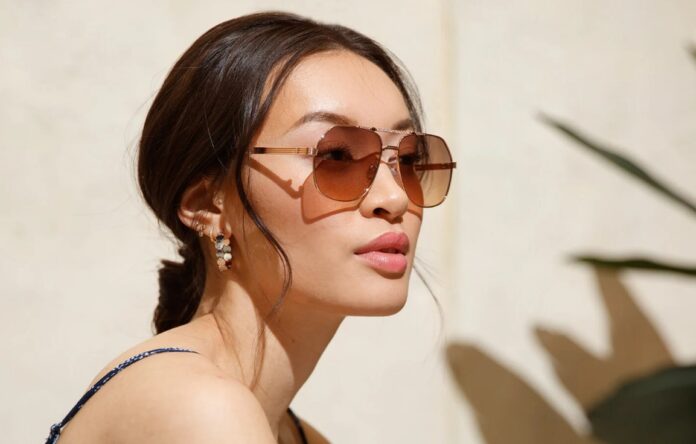
Now that you know which sunglass specifications to look for based on the unique characteristics of your face, you can shop with confidence.
Remember to always try frames on in natural lighting to see their shaping effects accurately.
With a flattering pair suited to your proportions and coloring, your face will stay vividly defined and fashion-forward in the sun.

